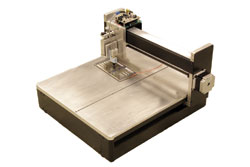Revolutionising fingerprint analysis
Applying the Electric Potential Sensor at a microscopic level
The research theme of citizenship and democratisation fosters collaborative work to tackle issues of freedom, violence and reconciling conflict in an insecure world.
Researchers at Sussex have developed an innovative, unique and highly sensitive method for measuring electrical fields, with a flexibility that allows its practical application in a diverse range of scientific and technological fields, from medical patient monitoring and diagnosis, to the forensic science of fingerprinting.

The prototype charge scanning instrument.
The Electric Potential Sensor (EPS), developed by researchers in Professor Robert Prance's group at the Centre for Physical Electronics and Quantum Technology, heralds a unique breakthrough in the measurement of electrical activity. This generic measurement technology provides a means of precisely measuring electrical charge that has the potential to be used in almost of any area of science and technology. Most recently, postdoctoral research assistant Sam Beardmore-Rust and DPhil student Philip Watson have been developing ways of using the technology at a microscopic level, including possible applications in the forensic science of fingerprinting.
Unlike all previous methods, the EPS provides a non-invasive sensor for detecting electrical charge, in a manner analogous to the measurement of magnetic fields using a magnetometer. These sensors can give a precise reading of electrical potential merely by being in close proximity - without being connected - to the source material, and are able to measure low-intensity, low-frequency electrical activity with a far higher degree of sensitivity than existing voltmeters, opening up all manner of possibilities for practical application. The EPS technology is already being applied in medicine to acquire electrophysiological signals such as electrocardiograms, and the first batch of commercially manufactured sensors for medical use are now being tested in the field.

A fingerprint left in charge, as measured on the prototype.
A new way of seeing fingerprints
As the EPS electrodes can be made on any scale, some of the group's latest research has involved scaling down the technology to a microscopic level. These microscopic sensors are able to detect charge over a distance of 5 microns - close to the limit of an optical microscope - allowing the mapping of a high-resolution image of electrical charge that occurs over the surface of the source material, such as a human fingerprint. Traditional methods of fingerprinting remain important forensic tools but present certain limitations in terms of identifying the age of a print, differentiating prints of interest or importance from background 'clutter' at a scene, and destroying DNA material through the necessary chemical processing of the print. The EPS offers several possible advantages in this context. Firstly, because the electrical charge laid down with the print decays over time, it allows temporal as well as spatial analysis in terms of providing an accurate timeline for the print. Secondly, the non-invasive nature of the technology means that biological material in the print is not destroyed by chemical processing and can still be harvested for DNA analysis. It would also allow the analyst to harvest material selectively, potentially saving time by avoiding indiscriminate DNA analysis of all prints in a given area.
The development of this technology is ongoing, funded in part by a grant from the EPSRC, and has many other potential applications at both the macroscopic and microscopic level. An improved understanding of the presence and movement of electrical charge could be applied in many areas where charge needs to be tightly controlled, such as semi-conductor fabrication and printing, ultimately leading to improved efficiency and significant cost reduction.
Sam's perspective

As part of a research team under the leadership of Professor Robert Prance, I've been working on a range of applications for a unique sensor developed at Sussex. Working with sensors involves operating in many diverse fields and, as a group, we've had to grapple with disciplines as varied as human physiology, telemedicine, microbiology, materials testing, security and safety and nuclear magnetic resonance, to name but a few. The opportunity to work in a multidisciplinary environment such as this has been incredibly rewarding, and I'm constantly confronted with exciting challenges and new areas of knowledge to explore. As a DPhil student, and more recently as a postdoctoral researcher, I've had opportunities to speak about and present my work at international conferences and publish my work in journals. Attending conferences in such different areas is a daunting experience, but one that could never be described as dull. I've also had the pleasure of teaching, and of course learning from, a large number of undergraduate students. This full and broad experience of an academic research environment has, I'm sure, given me a great foundation on which to base my work in the future.
Sam Beardsmore-Rust
Postdoctoral research assistant

